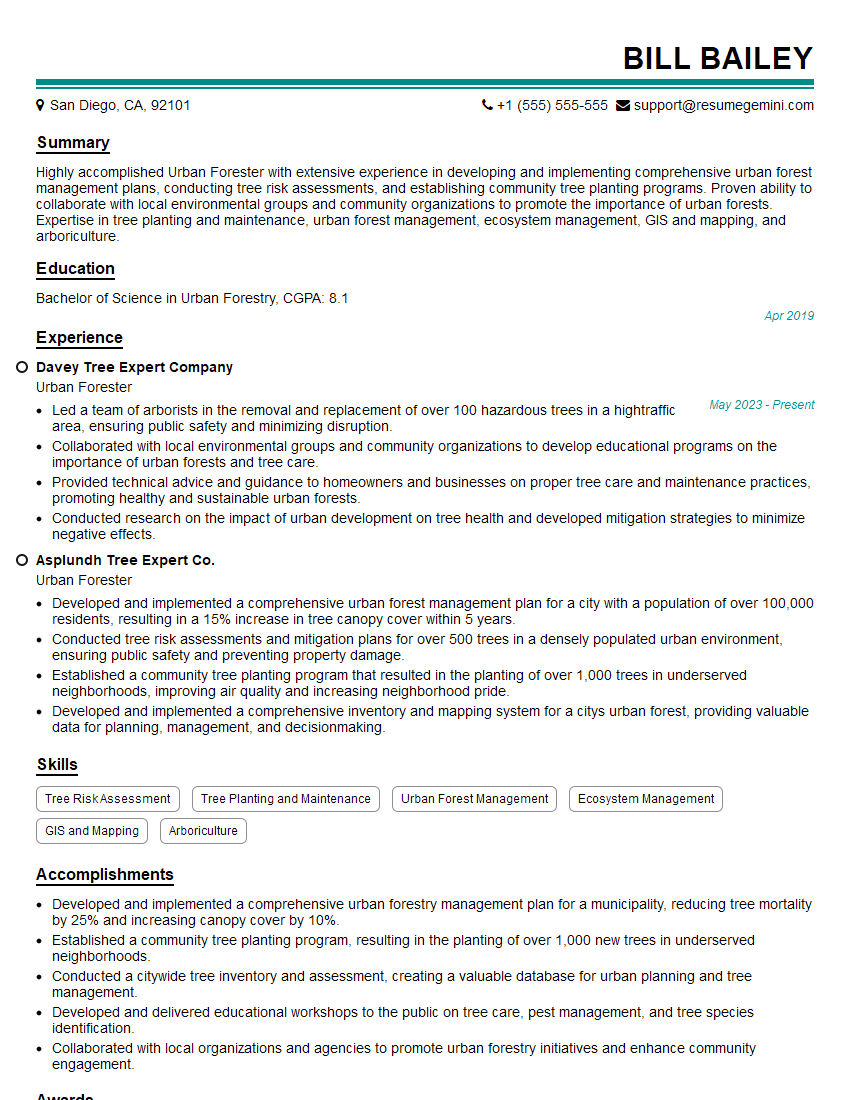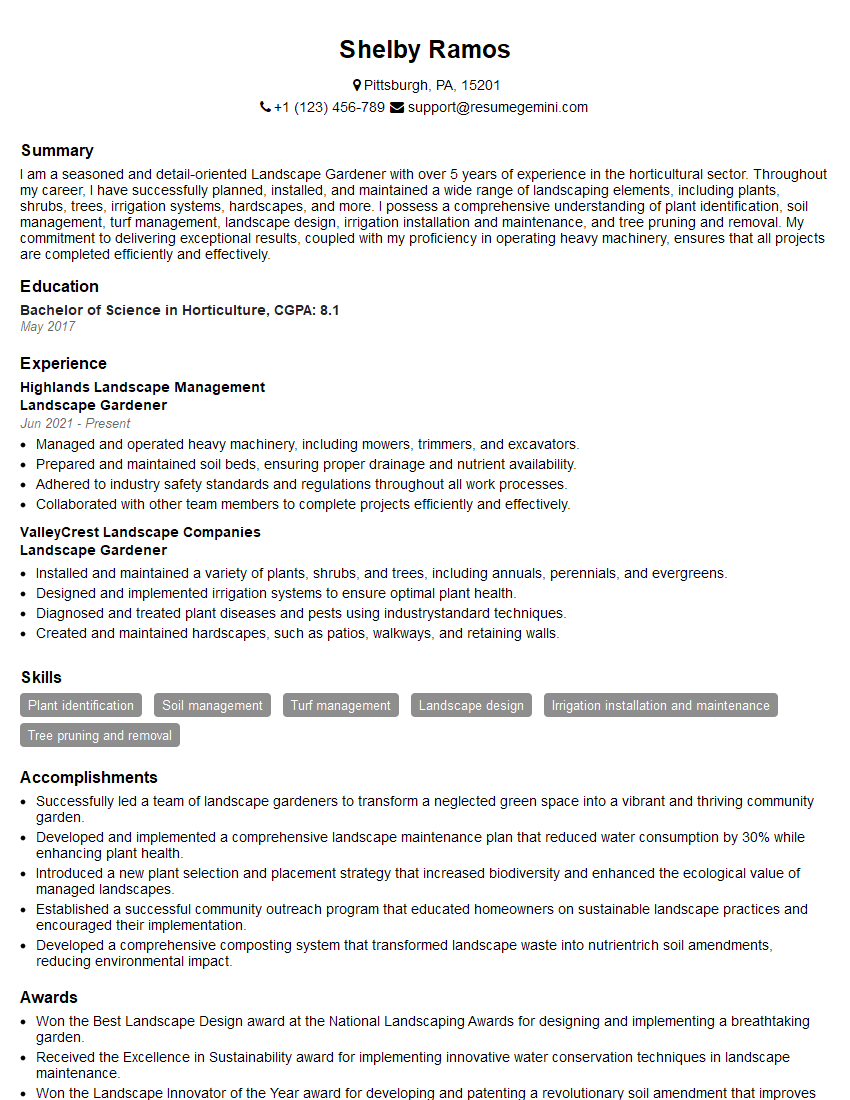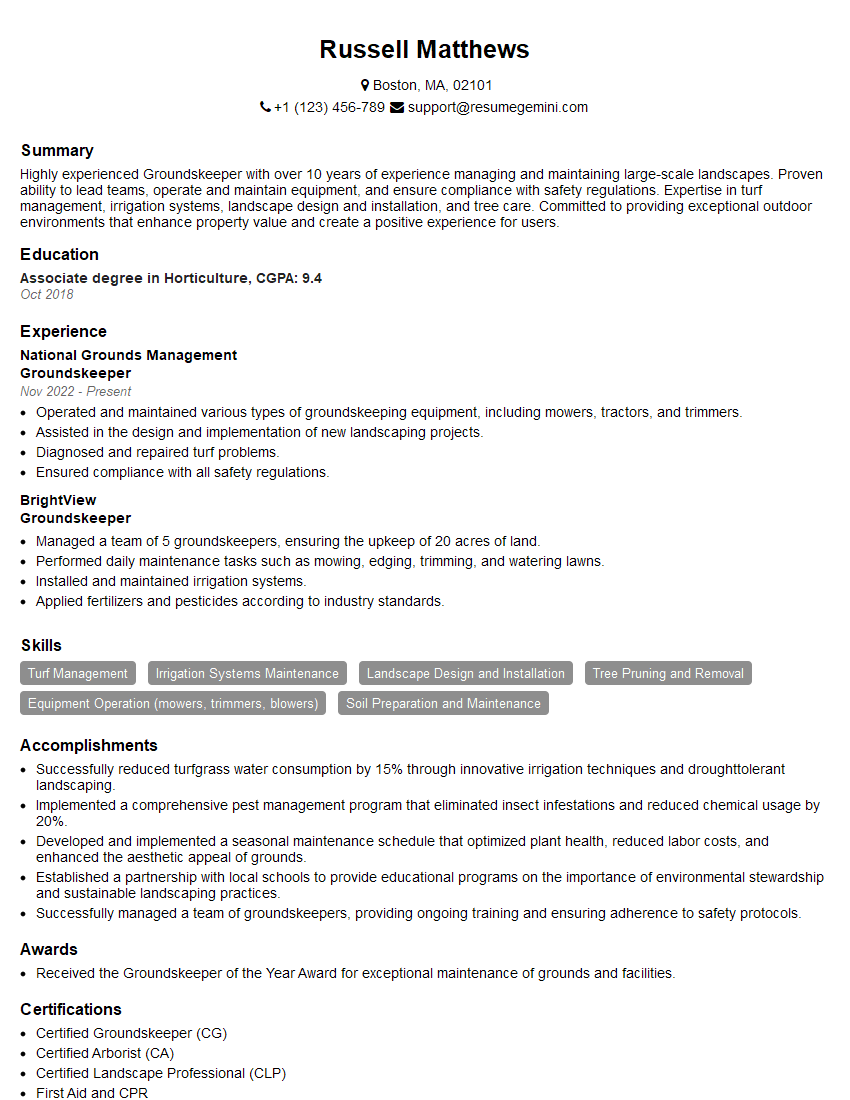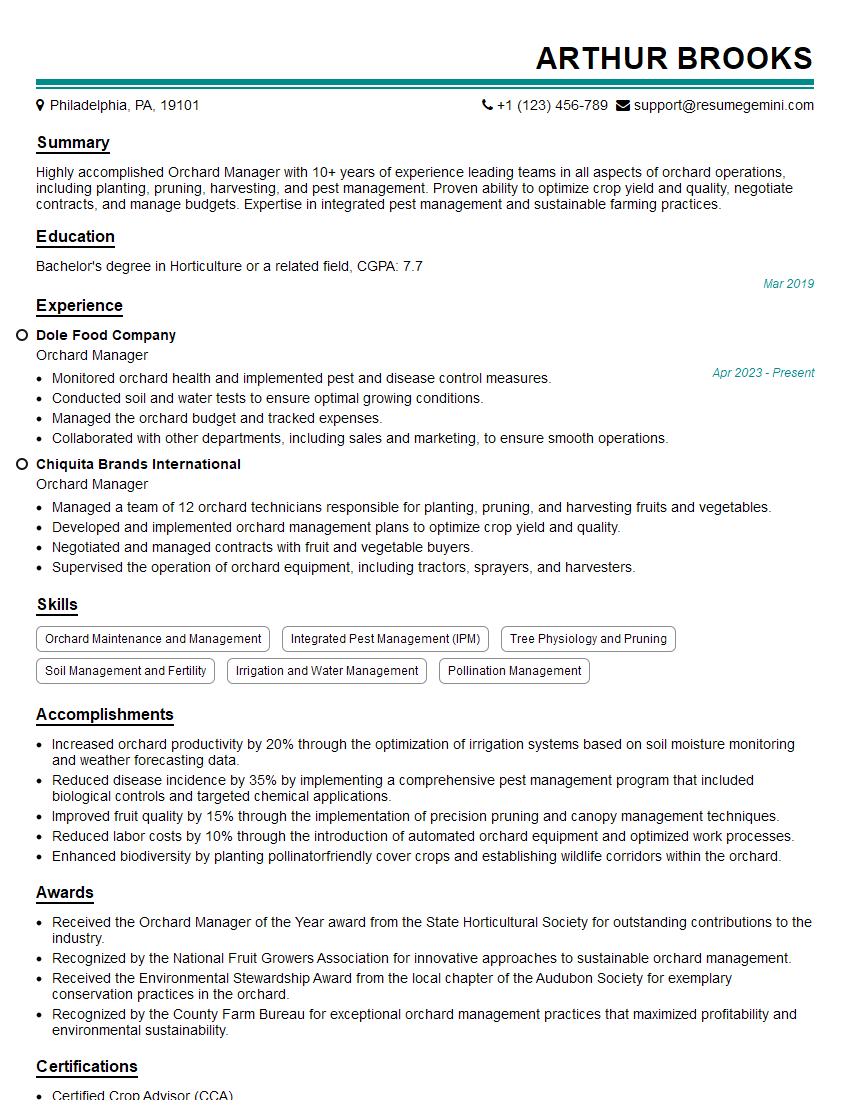Feeling uncertain about what to expect in your upcoming interview? We’ve got you covered! This blog highlights the most important Plant pruning interview questions and provides actionable advice to help you stand out as the ideal candidate. Let’s pave the way for your success.
Questions Asked in Plant pruning Interview
Q 1. Explain the difference between heading and thinning cuts in pruning.
Heading and thinning cuts are two fundamental pruning techniques with distinct purposes. Think of it like sculpting a bonsai – heading cuts shape the overall form, while thinning cuts adjust the density.
Heading cuts remove the terminal portion of a branch, encouraging branching from lower buds. This is ideal for shaping hedges, controlling height, and promoting bushier growth. Imagine trimming a boxwood hedge – each cut you make at the tip promotes new growth along the sides, creating a dense and even hedge.
Thinning cuts remove entire branches back to their point of origin, a lateral branch or the main stem. This improves air circulation, sunlight penetration, and overall plant health. It’s like thinning a forest to allow smaller trees to grow – removing overcrowded branches allows the remaining branches to thrive. For example, removing a congested inner branch of a rose bush allows more light and air to reach the remaining flowers and leaves.
Q 2. Describe the proper techniques for pruning different types of plants (e.g., shrubs, trees, roses).
Pruning techniques vary significantly depending on the plant type. Here’s a breakdown:
- Shrubs: Most shrubs benefit from light pruning annually. Remove dead, damaged, or diseased branches. For shaping, use heading cuts to maintain size and form. For example, a lilac after flowering could benefit from thinning out some older canes to promote new growth.
- Trees: Pruning trees often requires specialized knowledge depending on the species and its maturity. Young trees may need pruning to establish a strong central leader. Mature trees primarily require removal of dead, diseased, or crossing branches. Always consult a certified arborist for larger trees.
- Roses: Rose pruning depends on the type (hybrid tea, floribunda, etc.). Hybrid tea roses typically require heavier pruning in late winter to early spring, removing dead canes and shaping the bush. Floribundas require less aggressive pruning. After flowering, deadheading (removing spent blooms) encourages repeat flowering.
Regardless of the plant, always use sharp, clean tools to make clean cuts to minimize damage and disease spread.
Q 3. What are the signs of disease or pest infestation that you would look for during pruning?
During pruning, I meticulously examine plants for signs of disease and pest infestation. Early detection is crucial for effective management.
- Disease: Look for cankers (sunken, discolored areas on branches), leaf spots, wilting, dieback, unusual growths, or discoloration. The presence of powdery mildew (white coating on leaves) or fungal growths should be noted.
- Pest Infestation: Check for evidence of insect activity, such as holes in leaves or stems, webbing, sap oozing, insect frass (droppings), or the insects themselves. Look closely for signs of chewing, gall formation or other unusual leaf patterns.
If I find signs of disease or pests, I’ll take appropriate action, which may include removing affected parts, applying an approved treatment, or consulting with a plant health professional.
Q 4. How do you determine the appropriate timing for pruning various plants?
Timing is crucial for successful pruning. The best time to prune varies greatly depending on the plant type and its flowering cycle:
- Spring bloomers (e.g., lilacs, forsythia): Prune immediately after flowering to avoid removing next year’s flower buds.
- Summer bloomers (e.g., roses, crape myrtles): Prune in late winter or early spring before new growth begins.
- Evergreens (e.g., junipers, pines): Typically pruned in late winter or early spring, or lightly throughout the growing season as needed.
Avoid pruning during extreme weather conditions (frost, heat waves). Always consult reliable plant care guides for species-specific recommendations.
Q 5. What safety precautions do you take when using pruning tools?
Safety is paramount when using pruning tools. I always follow these precautions:
- Wear appropriate safety gear: This includes safety glasses or a face shield, gloves, and sturdy footwear to protect against cuts and injuries.
- Use sharp, well-maintained tools: Dull tools require more force, increasing the risk of injury and causing damage to the plant.
- Be aware of your surroundings: Avoid pruning near overhead power lines or in areas where falling branches could cause harm.
- Use proper lifting techniques: If lifting heavy branches, use proper body mechanics to avoid strain or injury.
- Store tools safely: Clean and store tools properly to prevent accidents.
Q 6. Explain the importance of proper tool sterilization in pruning.
Proper tool sterilization is crucial to prevent the spread of diseases and pests among plants. Imagine using an infected tool on a healthy plant – it’s like spreading a contagious illness!
Before and after each pruning task, I sterilize my tools. This can be done by wiping them down with a 10% bleach solution or 70% isopropyl alcohol. Alternatively, a flame sterilization method can be used (carefully!), burning off any pathogens.
Sterilization prevents the transmission of pathogens and ensures plant health.
Q 7. How do you identify different types of pruning cuts (e.g., clean cuts, flush cuts)?
Different pruning cuts serve specific purposes:
- Clean cuts: Made just outside the branch collar (the slightly swollen area at the base of the branch). These cuts allow for proper healing and prevent decay. This is the most common and preferred type.
- Flush cuts: Made even with the main stem or branch. These are generally avoided as they can create difficulties for healing and increase the risk of disease entry. It should only be used on deadwood or extremely small branches.
- Thinning cuts: Remove an entire branch back to its point of origin (as explained earlier).
Understanding these different cuts is key to effective pruning and ensuring plant health.
Q 8. What are the consequences of improper pruning techniques?
Improper pruning techniques can have devastating consequences for plant health and longevity. Think of pruning as a form of surgery – a precise procedure requiring knowledge and skill. Incorrect cuts can lead to:
- Disease and pest infestation: Large, improperly made cuts create entry points for diseases and pests. Imagine a wound on your skin – it’s vulnerable to infection. Similarly, a ragged cut on a plant is much more susceptible to pathogens.
- Weak growth and structural damage: Cutting branches too close to the trunk (leaving stubs) or cutting at the wrong angle can prevent proper healing and lead to weakened branches, making the plant more prone to wind damage or breakage. It’s like trying to mend a broken bone without proper alignment – it will never heal correctly.
- Dieback and plant death: Severe pruning mistakes, like removing too much foliage or damaging the cambium layer (the living tissue under the bark), can severely stress the plant, leading to dieback or even death. This is equivalent to losing too much blood during a surgery; the plant simply can’t recover.
- Reduced flowering and fruiting: Pruning affects the plant’s energy allocation. Incorrect pruning can reduce the number of flowers or fruits produced the following season. Imagine pruning away the flower buds of a fruit tree – you’ve lost the potential harvest for that year!
Therefore, mastering proper pruning techniques is crucial for maintaining plant health and achieving desired aesthetic or productive outcomes.
Q 9. Describe your experience with different pruning tools (e.g., hand pruners, loppers, pole saws).
My experience spans a wide range of pruning tools, each suited to specific tasks and plant sizes. Hand pruners are my go-to for precise cuts on smaller branches up to about ¾ inch in diameter. I prefer bypass pruners for clean cuts that minimize damage to the branch. For larger branches, up to 2 inches in diameter, I use loppers, ensuring a clean cut by using both hands for leverage and control. I’ve also extensively used pole saws for reaching high branches in larger trees, which requires careful technique to avoid accidental damage to surrounding branches or the trunk. Safety is paramount when using any of these tools; I always wear appropriate safety gloves and eye protection. The right tool for the job is key, and understanding the nuances of each tool significantly improves the efficiency and precision of the pruning process.
Q 10. How do you manage pruning debris responsibly?
Responsible management of pruning debris is vital for environmental stewardship and disease prevention. I never leave pruning waste on the ground. My approach involves several steps:
- Sorting: I sort the debris, separating healthy material from diseased or infested branches. This prevents the spread of disease.
- Composting: Healthy prunings are ideal for composting, enriching the soil with valuable nutrients. This is a sustainable way to recycle organic waste.
- Disposal: Diseased or heavily infested material needs to be disposed of properly, ideally by burning (following local regulations) or bagging for landfill disposal to avoid contaminating other plants or the soil.
- Chipping: Larger branches are often chipped and reused as mulch in the garden, helping to retain moisture and suppress weeds, offering a practical solution.
It’s always crucial to check with local regulations regarding the disposal of plant waste, especially if dealing with potentially invasive species.
Q 11. What are the key considerations when pruning plants in different seasons?
Seasonal considerations are critical for effective pruning. Different seasons affect plant physiology, influencing the success and outcome of the procedure.
- Dormant Season (Winter): This is ideal for pruning many deciduous trees and shrubs, minimizing sap loss and stress. It’s easier to see the structure of the plant when it’s leafless. Avoid pruning during periods of severe frost or freezing temperatures.
- Early Spring (Before Bud Break): This is a good time to prune some fruit trees before they begin to bud, allowing for effective shaping and the removal of damaged or diseased wood. Avoid pruning during periods of heavy rains or excessive humidity.
- Spring and Summer: These seasons are often suitable for “light pruning” – pinch back or shear annuals and lightly trim hedges for maintaining shape. However, major pruning during these seasons can lead to significant sap loss and stress on the plant.
- Late Summer/Early Autumn: A good time for selective pruning of flowering shrubs that bloom in the spring. Avoid pruning at a time that would interfere with the plant’s natural flowering or fruiting cycle.
Knowing the specific needs of each plant and its flowering/fruiting cycle is essential for successful seasonal pruning.
Q 12. Explain the concept of wound dressing and when it is appropriate to use it.
Wound dressing, the application of a sealant to a pruning wound, is a somewhat controversial topic. While it was once commonly recommended, current research suggests that in most cases, wound dressing isn’t necessary and may even be detrimental.
Plants have natural mechanisms to seal and protect their wounds. Wound dressings can sometimes trap moisture, creating an environment that is conducive to fungal growth and infection. There are exceptions, such as when dealing with particularly large wounds on mature trees where the risk of disease is higher. In such cases, a specialized wound dressing formulated for plant use might be considered. The application should be done correctly and in accordance with the product instructions. It’s always best to consult with a certified arborist or horticulturalist before using wound dressing.
Q 13. How do you assess the overall health of a plant before pruning?
Assessing the overall health of a plant before pruning is a critical first step. This involves a thorough examination to identify any signs of stress, disease, or pests.
- Visual Inspection: Examine the plant’s overall structure, checking for dead, damaged, or diseased branches. Look for signs of pests like insects or fungal growth.
- Leaf Examination: Check the leaves for discoloration, wilting, or unusual spots, indicating potential diseases or nutrient deficiencies.
- Trunk and Branches: Inspect the trunk and main branches for any cracks, wounds, or signs of decay. Feel the bark for any signs of unusual texture or softness.
- Root System: If possible, assess the root system for signs of damage or rot, particularly if the plant has been stressed.
Understanding the plant’s history, including any known diseases or pests, and considering its growing conditions are also important aspects of the pre-pruning assessment. This thorough evaluation informs the pruning strategy and ensures the plant’s well-being after the procedure.
Q 14. What are the common pruning mistakes to avoid?
Several common pruning mistakes can significantly harm plants. Avoiding these errors is vital for maintaining plant health and achieving desired outcomes.
- Topping: Removing the top of a tree or shrub creates unsightly and weak growth, making it more vulnerable to disease and damage.
- Incorrect Cut Angles: Making flush cuts (cutting too close to the branch collar) or leaving stubs prevent proper healing and increase the risk of disease. Cuts should be made just outside the branch collar at a slight angle.
- Over-Pruning: Removing too much foliage weakens the plant and can lead to dieback or death. It is important to know how much you can prune based on the plant’s type and size.
- Pruning at the Wrong Time: Pruning during periods of stress (e.g., extreme heat or cold) or during the plant’s active growing season can severely weaken the plant.
- Using Dull Tools: Dull pruning tools cause ragged cuts that increase the risk of disease and damage. Always use sharp, clean tools for every pruning job.
Careful planning and execution, coupled with sound knowledge of pruning techniques, are key to avoiding these common mistakes.
Q 15. Describe your experience with pruning specific plant types (e.g., fruit trees, flowering shrubs).
My experience with pruning encompasses a wide range of plant types, focusing on both the aesthetic and health aspects. With fruit trees, like apple and pear trees, I prioritize techniques that maximize fruit production while maintaining tree structure. This involves winter pruning to remove dead, damaged, or diseased wood, as well as summer thinning to improve air circulation and sunlight penetration for better fruit development. For example, I’d remove crossing branches that could rub against each other and cause damage, and thin out overly dense areas to prevent disease. With flowering shrubs, such as roses and hydrangeas, the focus shifts slightly. Pruning is often done to stimulate blooms, remove spent flowers, and maintain shape. Knowing the specific flowering habit of each shrub is crucial—some bloom on old wood, others on new growth. Incorrect pruning can significantly impact flower production. For instance, pruning a rose bush that flowers on old wood too aggressively will drastically reduce the following season’s blooms. I carefully consider the plant’s type and its specific requirements before I begin any pruning.
Career Expert Tips:
- Ace those interviews! Prepare effectively by reviewing the Top 50 Most Common Interview Questions on ResumeGemini.
- Navigate your job search with confidence! Explore a wide range of Career Tips on ResumeGemini. Learn about common challenges and recommendations to overcome them.
- Craft the perfect resume! Master the Art of Resume Writing with ResumeGemini’s guide. Showcase your unique qualifications and achievements effectively.
- Don’t miss out on holiday savings! Build your dream resume with ResumeGemini’s ATS optimized templates.
Q 16. How do you deal with overgrown or neglected plants?
Dealing with overgrown or neglected plants requires a phased approach. The first step involves assessing the plant’s overall health and condition. This includes identifying any dead, diseased, or damaged branches, as well as determining the extent of overgrowth. A gradual approach is often best, particularly with severely neglected plants, to avoid shocking the plant and potentially causing further damage. We might start by removing the most obvious dead and damaged wood. Subsequent prunings can then be carried out over several seasons, gradually reducing the size and shaping the plant back to a more desirable form. Regular fertilization and watering can also play a major role in helping the plant recover. Imagine an overgrown hedge; you wouldn’t just completely lop it off – you’d gradually reduce its size over several seasons, allowing it to recover and regain its vigor.
Q 17. What is your approach to pruning large trees?
Pruning large trees is a specialized task that often requires professional arborists with specialized equipment and training. Safety is paramount. Before any pruning begins, a thorough assessment is required, which may involve using climbing gear, aerial lifts, or even sophisticated imaging techniques to inspect the entire tree’s structure, including potentially hidden decay. The goal is to remove dead, diseased, or structurally weak branches that could pose a risk, as well as to maintain the tree’s overall health and shape. The techniques used will depend on the species of tree and its specific condition. Crown thinning and reduction may be necessary, and any cuts must be made cleanly to avoid causing further damage. Improper pruning of large trees can lead to serious damage or even tree failure, so working with experienced professionals is essential.
Q 18. How do you determine the appropriate height and shape for a pruned plant?
Determining the appropriate height and shape depends largely on the plant’s species, its intended purpose, and the overall landscape design. For example, a fruit tree needs sufficient height and spread for optimal sunlight and fruit production, while a flowering shrub might be pruned to create a specific shape or to enhance flowering. Consider factors like the surrounding environment – neighboring plants, structures, and even prevailing winds. The desired aesthetic also plays a role; formal hedges require precise shaping, while informal plantings allow for more natural forms. I often use reference images or sketches to help visualize the final result, keeping in mind the plant’s natural growth habit to ensure a realistic and sustainable outcome. I always take into consideration the long-term health and aesthetic appeal when establishing a plant’s height and shape.
Q 19. Describe your experience with pruning techniques for different plant growth habits.
Different plant growth habits necessitate different pruning approaches. Plants that have a single central leader (e.g., many conifers) are pruned to maintain that central leader while removing competing branches. Plants with multiple stems (e.g., many shrubs) may benefit from thinning out branches to improve air circulation and light penetration. Knowing whether a plant flowers on old wood (last year’s growth) or new wood (current year’s growth) is crucial for effective pruning. Pruning a plant that blooms on old wood too heavily will significantly reduce its flowering the following year. I use various pruning techniques, including heading cuts (removing the tip of a branch to stimulate branching) and thinning cuts (removing entire branches back to a lateral branch) to manage growth, shape, and flowering. Each plant’s unique growth habit is carefully studied before beginning any work.
Q 20. How do you handle difficult pruning situations (e.g., entangled branches, diseased limbs)?
Difficult pruning situations require careful planning and often involve specialized tools and techniques. Entangled branches require patience and precision to untangle without causing damage to the branches. In some cases, it might be necessary to remove portions of the entangled branches to separate them. Diseased limbs should be removed well beyond the visibly affected area to prevent the spread of disease. The pruning cuts should be clean and made at the proper angle to allow for efficient healing. Safety is paramount – I would use appropriate safety equipment and consider if I need assistance for particularly large or heavy branches. Proper sanitation of tools between plants is also essential to prevent the spread of disease. For example, if dealing with a diseased branch on a fruit tree, proper disposal of the branch to prevent spread of infection is essential.
Q 21. What are the principles of shaping and maintaining hedges?
Shaping and maintaining hedges is a matter of consistent, precise pruning. The principles involve establishing a desired shape and then regularly trimming the hedge to maintain that shape. This usually involves using hedging shears to create straight lines and even surfaces. To avoid creating a dense, unhealthy hedge, regular thinning cuts should be incorporated to improve air circulation and light penetration. The frequency of pruning depends on the species of plant and the rate of growth. Some hedges require regular trimming several times a year, while others may only need to be pruned once or twice. Proper pruning will lead to a lush, healthy hedge with consistent growth. When shaping the hedge, avoid creating a flat top; a slight slope will allow better water runoff and prevent damage from snow and ice.
Q 22. How do you ensure plant safety and minimize stress during pruning?
Minimizing stress during pruning is paramount for plant health. It’s like giving a plant a well-planned haircut instead of a butchering! We achieve this through several key strategies. First, we always prune at the right time of year, avoiding periods of active growth or extreme temperatures. This allows the plant to heal more efficiently. Second, we use sharp, clean tools to make precise cuts that minimize wounding. Jagged cuts create larger entry points for diseases. Third, we avoid removing more than 25-30% of the plant’s foliage in a single session to prevent shock. Think of it as gradually slimming down, not a drastic diet. Finally, we might apply a wound sealant to larger cuts to prevent infection, especially in susceptible species. This is like putting a bandage on a deep cut.
For example, when pruning a rose bush, I would carefully remove dead or diseased canes, shape the bush, and thin out crowded branches, always ensuring to make clean cuts just above an outward-facing bud. This promotes healthy new growth without overwhelming the plant.
Q 23. Explain your understanding of plant physiology related to pruning.
Plant physiology plays a crucial role in understanding the effects of pruning. Pruning stimulates the plant’s natural response mechanisms. When we remove branches, we’re interrupting the flow of auxins (plant hormones responsible for growth), which triggers the production of cytokinins (hormones that promote cell division). This leads to new bud growth and potentially more vigorous branching. Removing apical dominance (the tip of a stem), for example, allows lateral buds to develop, leading to bushier plants. Understanding the plant’s natural hormonal balance is key to predicting its response to pruning. Different plants react differently – some will vigorously regrow, while others might require more careful, minimal pruning.
For instance, a vigorous-growing deciduous tree like a maple will respond well to more aggressive pruning to manage its size, while an older, slow-growing oak might need very little, focusing instead on removing only dead or diseased wood. Ignoring the plant’s physiological characteristics can lead to serious damage or even death.
Q 24. How do you adapt your pruning techniques to different environmental conditions?
Environmental conditions heavily influence pruning techniques. In arid climates, pruning should be done to reduce water stress, possibly concentrating on removing inward-growing branches to increase air circulation. In areas with harsh winters, pruning might be postponed until late winter or early spring to avoid frost damage to fresh cuts. High winds might necessitate pruning to reduce the plant’s wind resistance, while pruning in areas with frequent rainfall should focus on preventing the spread of fungal diseases. Think of it as adapting your haircut to the weather – you might keep your hair shorter in the summer heat.
For example, in a region prone to heavy snowfall, I would prune trees in late winter to minimize the weight on the branches during the snow season, reducing the risk of breakage. On the other hand, in a dry climate, I would prune to create more airflow and reduce moisture loss.
Q 25. How do you maintain your pruning tools to ensure optimal performance?
Maintaining pruning tools is critical for both plant health and safety. Sharp tools make cleaner cuts, reducing the risk of disease and stress on the plant. I regularly sharpen my bypass pruners and loppers using a sharpening stone, ensuring they maintain a clean, sharp edge. After each use, I clean the tools with a disinfectant solution to prevent the spread of pathogens between plants. Lubricating moving parts with a suitable lubricant keeps them functioning smoothly and extends their lifespan. Proper storage in a dry place protects them from rust and damage.
I consider tool maintenance as crucial as the pruning itself, as dull tools can cause ragged wounds that create entry points for diseases. Regular cleaning and sharpening are not just about tool longevity but also plant health.
Q 26. Describe a time you had to troubleshoot a pruning problem. What was the outcome?
I once encountered a case of dieback on a young fruit tree. Initial pruning had focused solely on shaping, neglecting the presence of several dead branches. The dieback continued to spread. Troubleshooting involved: (1) carefully examining the tree for signs of disease or pest infestation; (2) removing all dead and diseased wood back to healthy tissue, sterilizing my tools between each cut; (3) applying a fungicide to prevent further spread; (4) improving soil drainage to address potential root problems; and (5) adjusting the pruning strategy to ensure adequate air circulation and sunlight penetration.
The outcome was successful. After implementing these steps, the dieback stopped, and the tree started to show healthy new growth. The key lesson was to be thorough in assessment, identify the root cause, and adopt a holistic approach to solving the problem. It taught me that seemingly simple pruning issues can have complex underlying factors.
Q 27. What are your strategies for managing large-scale pruning projects?
Managing large-scale pruning projects requires careful planning and organization. It’s akin to directing a small army! I begin with a thorough site assessment, identifying the species of plants, their size, and the objectives of the pruning project. A detailed pruning plan is then created, outlining specific techniques and safety measures. The project is broken down into smaller, manageable tasks, assigning teams with specific responsibilities and timelines. Regular communication and monitoring are essential throughout the process to ensure efficiency and adherence to the plan. Finally, a post-project assessment evaluates the effectiveness of the pruning and identifies areas for improvement in future projects.
For example, when pruning a large orchard, we might use specialized equipment like elevated work platforms and chippers to increase efficiency. We’d also ensure sufficient personnel are available to handle the task safely and efficiently, possibly involving multiple teams working in a coordinated manner.
Key Topics to Learn for Plant Pruning Interview
- Plant Physiology & Growth Habits: Understanding plant biology, growth cycles, and the impact of pruning on these processes. Practical application: Explaining how different pruning techniques affect flowering, fruiting, and overall plant health.
- Pruning Techniques & Tools: Mastering various pruning methods (heading, thinning, shaping) and selecting appropriate tools for different plants and situations. Practical application: Describing the proper use of hand pruners, loppers, and saws, and when each is most effective.
- Plant Identification & Pruning Needs: Accurate identification of plant species and understanding their unique pruning requirements. Practical application: Differentiating pruning needs between deciduous and evergreen trees, shrubs, and flowering plants.
- Disease & Pest Management through Pruning: Recognizing and addressing disease or pest issues through proper pruning techniques. Practical application: Explaining how pruning can prevent the spread of disease and improve air circulation to reduce pest infestations.
- Safety Procedures & Best Practices: Prioritizing safety while using pruning tools and working at heights. Practical application: Describing safe work practices including proper PPE (Personal Protective Equipment) usage and risk mitigation strategies.
- Pruning for Specific Purposes: Understanding the techniques for rejuvenation pruning, shaping, training, and size control. Practical application: Explaining the differences in pruning methods used to maintain a hedge versus a fruit tree.
- Environmental Considerations: Integrating sustainable pruning practices that minimize environmental impact. Practical application: Discussing responsible disposal of plant debris and minimizing water usage after pruning.
Next Steps
Mastering plant pruning opens doors to exciting career opportunities in horticulture, landscaping, arboriculture, and more! A strong understanding of these techniques demonstrates valuable skills to potential employers. To significantly boost your job prospects, it’s crucial to create a resume that showcases your expertise effectively and is easily parsed by Applicant Tracking Systems (ATS). We highly recommend leveraging ResumeGemini, a trusted resource, to build a professional and ATS-friendly resume that highlights your unique skills and experience. ResumeGemini provides examples of resumes tailored to plant pruning roles, helping you craft a document that stands out from the competition.
Explore more articles
Users Rating of Our Blogs
Share Your Experience
We value your feedback! Please rate our content and share your thoughts (optional).
What Readers Say About Our Blog
Hello,
We found issues with your domain’s email setup that may be sending your messages to spam or blocking them completely. InboxShield Mini shows you how to fix it in minutes — no tech skills required.
Scan your domain now for details: https://inboxshield-mini.com/
— Adam @ InboxShield Mini
Reply STOP to unsubscribe
Hi, are you owner of interviewgemini.com? What if I told you I could help you find extra time in your schedule, reconnect with leads you didn’t even realize you missed, and bring in more “I want to work with you” conversations, without increasing your ad spend or hiring a full-time employee?
All with a flexible, budget-friendly service that could easily pay for itself. Sounds good?
Would it be nice to jump on a quick 10-minute call so I can show you exactly how we make this work?
Best,
Hapei
Marketing Director
Hey, I know you’re the owner of interviewgemini.com. I’ll be quick.
Fundraising for your business is tough and time-consuming. We make it easier by guaranteeing two private investor meetings each month, for six months. No demos, no pitch events – just direct introductions to active investors matched to your startup.
If youR17;re raising, this could help you build real momentum. Want me to send more info?
Hi, I represent an SEO company that specialises in getting you AI citations and higher rankings on Google. I’d like to offer you a 100% free SEO audit for your website. Would you be interested?
Hi, I represent an SEO company that specialises in getting you AI citations and higher rankings on Google. I’d like to offer you a 100% free SEO audit for your website. Would you be interested?
good








